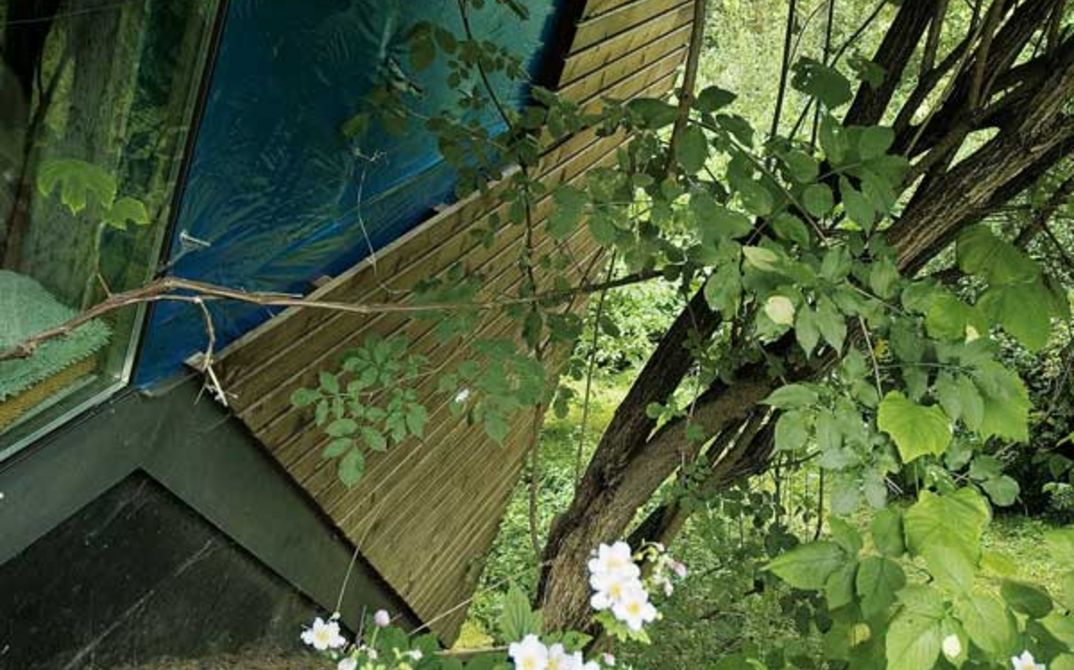Forum expanded Talk and Show
Episode 1: Sense of Architecture
07.02. 12:00 - 16:00 Hamburger Bahnhof - Museum für Gegenwart (tickets required for the screening)
The film Sense of Architecture shows 42 contemporary architectural projects of Austrian origins. As an independent work, it emerged from the material for 57 short films that Heinz Emigholz produced for the traveling exhibition conceived in Graz, Sense of Architecture. Unlike the exhibition, which grouped the architecture thematically, the new film assembles the project into a social reality in which modern buildings were constructed for all areas of life.
The film begins with a bell tower in the Seetaler Alps and a construction site and then leads through the various stages of a fictive life: from a kindergarten, a single-family home, a botanical garden, a track house, a pharmacy, a housing development, a museum for children, an apartment house with a workshop, a dialect institute, an art house, an office building, a school, a shoe shop, an apartment block, a town hall, a community center, a medical center, past a pedestrian bridge, in a room for studying, an airport tower, a church reconstruction, a community center, a regional exhibition, a residential area, a city council, a renovated castle, a villa, a restaurant, a hall, a building extension, a justice center, a prison, a cloister, an art house, a hospital, a vacation house, a castle, a museum, a stone house, a nursing home, a crematorium, and to a columbarium.
A plane on which to think
What is interesting for you, coming from drawing, from experimental film, about architecture, about the architecture film?
What interests me is architecture's capacity or incapacity to design and situate spaces in relation to the human body and mind. I have always perceived "space" as tricky. As the internal space of my own body and the external space in which I can or must move. Now at first, whether these are artificial or natural spaces plays no role, for me the whole relation rests on a knife’s edge. It took me nearly forty years to find something like a balance here. My films probably helped me in this regard. In the sense of an anchor, not in the sense of a media category or genre.
Is there a formal proximity between constructed spaces and film spaces for you?
They are products of two practically opposing processes of configuration. Architecture projects a spacial concept into reality and sets it up there as a three-dimensional situation. The film then takes this space and translates it with the camera into a two-dimensional image, which is projected before us in a temporal arrangement. This is a design process inscribed with the real. This repetition – from the idea to the real space and over the image’s surface and back again to the space of thinking–is remarkable. But, as everyone knows and as Kierkegaard found out, there are no "repetitions". Something else arises instead: a plane on which to think. Cinema produces a second physical presence in which an active spectator can newly reconfigure the story for himself. The capacity to understand, as Constantine Cavafy wrote so beautifully, is spoiled by fashions. My films are on the side of understanding.
Doesn’t a commissioned work like one documenting contemporary architecture in Styria present the problem of "recognizing the object"?
The works by the architects that I filmed in my series Architecture as Autobiography have had a great deal to do with this contemporary architecture. Many of the current ideas of space, construction tasks and solutions, converge in this contemporary practice. There were reasons why I was asked. They were derived from the knowledge of my film work. The curatorial decision to produce all the films and photographs for the exhibition is uncharted ground, and it happens so rarely that it played a decisive role in my decision. Typically, for exhibitions of this magnitude, already existing materials are merely collected and newly arranged. In this project, however, the connecting power lies between the works presented in one visual work that references all the participating objects – that is, in the primacy of producing new images through a particular gaze.
(from Marc Ries' conversation with Heinz Emigholz about his architecture films)
Germany/Austria 2005-2009, HDV, format 1:1.37, 168 minutes
Director, Camera, Editor: Heinz Emigholz
Camera and Editing assistance: Till Beckmann
Original sound: Till Beckmann
Audio, Editing and Mixing: Jochen Jezussek, Christian Obermaier
Post-production: Till Beckmann
Curator: Charlotte Pöchhacker
Producer: Heinz Emigholz Filmproduktion, Berlin in collaboration with Arge Artimage Kadadesign, Graz
Financial support: "kultur steiermark"
Heinz Emigholz, born 1948, is an artist and has been making films since 1973 (Forum 1974, 1975, 1976, 1979, 1982, 1984, 1991, 2001, 2003, 2005, 2007, 2008). Numerous exhibitions, retrospectives, and publications. Professor of Experimental Film at the University of the Arts Berlin.
